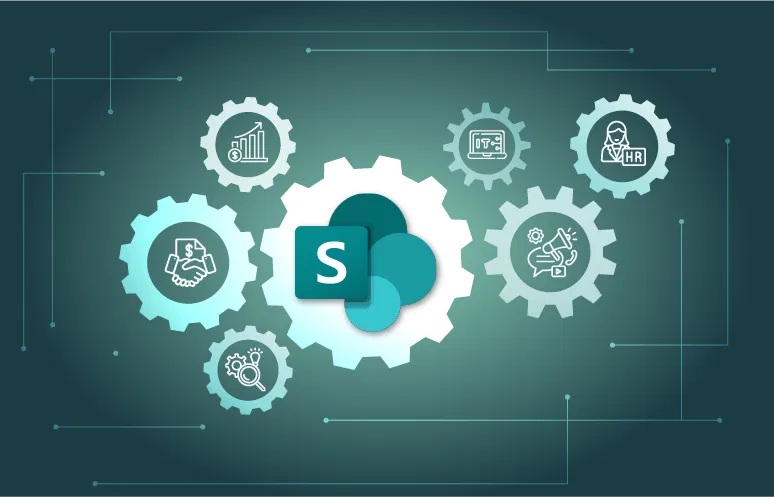It is a huge challenge for businesses, even today, to handle time-consuming processes. Employees are stuck doing manual, mundane and tedious tasks. This hampers the overall productivity of a company and in turn, impacts the entire business chain.
80% of time from a typical workday is spent doing tasks with little to no value and only 20% is spent doing something important. – Cornerstone Dynamics
Automating your tedious processes allows your workforce to focus on critical tasks at hand. It helps you improve operational efficiency, reduce costs and optimize business performance.
Microsoft’s Power Automate (previously known as Microsoft Flow) is one of the best workflow automation tools. Over 14,847 companies globally are using Power Automate as a cloud-integration tool in 2025. It can help you simplify many business processes that are mundane. In this blog, we will discuss fifteen use cases of Power Automate that can help you transform your business operations.
1. Automating data entry and processing
Data entry is an essential process for businesses that seek to reorganize data into standard formats for additional processing. However, it is a menial process that takes up a lot of time. Also, data entries that are done manually are prone to errors.
A Gartner study estimates that human data entry errors in finance processes add roughly 25000 hours of avoidable rework at a cost of $878,000 per year.
Power Automate development allows employees to focus on high-value tasks that impact overall productivity while automating the data entry process. Eliminate the inefficiencies of manual data entry by implementing RPA using Power Automate.
Steps to implement data entry automation
Step 1: Connect to the data sources. Power Automate supports various data sources, including Excel spreadsheets, databases, web forms and more.
Step 2: Specify how the data should be processed, such as checking for duplicates, validating data format, or calculating values.
Step 3: Power Automate will automatically capture the data from the source and process it as per the rules in real time.
Step 4: You can choose to store the data in a database, an Excel spreadsheet, a SharePoint list, or any other supported format.
Benefits of RPA development in data entry and processing
- Eliminate human error by automatically processing data, ensuring that the data is accurate and up to date
- Store and manage your data in a centralized location, making it easier to access and analyze
- Scale to accommodate the increased data processing needs
2. Streamlining workflows and approvals
Approving your annual budget or sales deck is an essential part of any business. However, they can quickly become a bottleneck if not managed efficiently. Automating such workflows allows companies to save working hours and boost team productivity.
McKinsey research found that automation of 50-75% of workflows can lead to:
- 20-35% annual run-rate cost efficiencies
- 50-60% reduction in straight-through process time
Steps to implement automated workflows and approvals
Step 1: Identify the workflow that needs to be streamlined. This could be anything from a simple approval process for expenses to a complex, multi-step workflow for a project.
Step 2: You can specify who should be involved in the approval process, when they should be notified and what actions they should take.
Step 3: Define who must approve each step and set up rules for email notifications and escalation if approval is not received in time.
Step 4: Monitor and track workflows to gain visibility into its status at any time. This allows you to stay on top of any delays or issues and take actions as needed.
Benefits of workflow and approval automation with Power Automate
- Gain visibility into the status of workflows and approvals
- Identify and resolve issues
- Orchestrate processes
- Ensure process compliance
- Improve audit readiness
3. Automating email management
Targeted marketing is one of the most popular ways that companies implement to improve customer retention rate. According to EmailMonday, approximately 56% of companies use automation as part of their marketing campaigns. Email marketing has the third highest ROI of any marketing media.
Email marketing is expected to bring in almost $18 billion in revenue by 2027. – Statista
Power Automate allows you to automate your email marketing efforts. You can send personalized and targeted emails to your subscribers at specific intervals to stay connected. Email automation can also be used to trigger responses for any user activity. For example, you can utilize email automation to send payment confirmations or welcome emails.
Steps to implement email automation
Step 1: Connect to your email account. Power Automate supports multiple email services, including Exchange, Gmail and more.
Step 2: Specify how your emails should be managed.
Step 3: Automatically manage your email process like filing emails into folders, sending notifications and responding to emails.
Step 4: Monitor and track your emails to stay on top of any important emails.
Benefits of RPA implementation for email automation
- Increase productivity and reduce the risk of delays or miscommunication
- Efficient collaboration with stakeholders
4. Integration with other Microsoft tools such as SharePoint
Power Automate is a powerful tool for automating workflows and tasks. However, it’s even more effective when used in conjunction with other Microsoft tools, such as SharePoint. SharePoint provides a platform for storing and managing data and documents, while Power Automate is used to automate workflows. This allows you to efficiently streamline your business processes.
Steps to integrate SharePoint
Step 1: Connect Power Automate with SharePoint. Enter your SharePoint site URL and sign in with your Microsoft account.
Step 2: Configure the trigger by selecting the SharePoint list or library that you want to use. You can also specify any filter conditions to limit the scope of the trigger.
Step 3: Add one or more actions to the flow. For example, you can send an email, create a task in a to-do list, or update a SharePoint list.
Step 4: Test the flow by manually triggering it or by waiting for the trigger to be activated. Save the flow and activate it.
Benefits of integrating other tools with Power Automate
- Automatically trigger notifications, alerts and reminders to keep team members informed and on track.
- Automatically integrate data from various sources and platforms, including SharePoint, into a single, unified system.
5. Automating customer service processes
It is important to meet consumers’ demands and expectations on time. In case of queries or grievances, customers expect a quick turnaround to resolve their issues.
90% of consumers regard resolution as their most important customer service issue. – KPMG
Customer service processes can be tedious and repetitive. Often, humans can’t respond to consumer queries in real time. This is where Power Automate comes into the picture. You can automate these processes and improve customer experience.
Steps to automate customer service processes
Step 1: Connect to your customer service tools. Power Automate supports multiple customer service tools, such as Zendesk, Salesforce and more. This makes it easy to connect to your existing tools.
Step 2: Define automation rules for workflows like routing requests to the appropriate team, sending notifications, or automatically responding to requests.
Step 3: Define the automation process to ensure that customer service requests are managed efficiently and effectively.
Step 4: Monitor and track customer service requests to gain visibility into the status of requests at any time.
Benefits of robotic process automation in customer service processes
- Keep your customers informed and engaged
- Access and update customer information in real-time
- Improve resolution times and customer satisfaction
Optimize operations with Power Automate consulting
Drive consistency and reduce manual effort through scalable automation strategies tailored to your business.
6. Automating HR processes
Onboarding new employees is an essential HR process. However, it is also a tedious process. By creating workflows with Power Automate, HR departments can automate repetitive manual tasks. This includes sending welcome emails, updating databases, new-hire announcements and to-do list completions.
25% of companies report using HR automation, mainly for recruitment and hiring. – Research from the Society for Human Resource Management (SHRM).
Steps to automate HR processes with Power Automate
Step 1: Connect to your HR tools. Power Automate supports multiple HR tools, such as Workday, BambooHR and more.
Step 2: Power Automate allows you to specify how onboarding processes should be managed. For example, automatically sending emails, updating HR databases and even sending automated reminders.
Step 3: Connect Power Automate with other systems that are involved in the HR process, like a human resources information system (HRIS), email and collaboration tools.
Step 4: Test, deploy and monitor the workflow to ensure continuous improvement.
Benefits of HR automation
- Mitigate the risk of errors and inaccuracies
- Get more reliable and accurate HR data
- Stay compliant with regulations and best practices
- Reduce the time it takes for new hires to become productive
7. Generating reports and analytics
Organizations need to manage data across multiple platforms to achieve their goals. Moreover, insights driven by data allow companies to make savvy business decisions. Power Automate makes it easy to sync and update data across platforms, helping businesses to achieve seamless data management.
Steps to automate reports and analytics
Step 1: Connect to your data sources. Power Automate supports a wide range of data sources, including Excel, SharePoint, SQL Server and more.
Step 2: Define the steps in the Power Automate flow to extract, transform and load data into the desired format.
Step 3: Set a schedule to run the flow at regular intervals, such as daily or weekly, to automatically update the reports and analytics.
Step 4: Share the automated reports and analytics with the relevant stakeholders through Power BI, Excel, or SharePoint.
Benefits of RPA implementations for data analytics
- Improved data accuracy
- Access to real-time data for faster and more informed decision-making
- Efficiently handle large amounts of data
- Easily scale to accommodate growing data needs
8. Automating IT processes such as password reset
Password reset is a common and repetitive task for the IT department. This can take up a lot of time and resources, slowing down the productivity of your team.
A report by Forrester Research concluded that about 20% of all support tickets are related to passwords and unlocking an account.
With Power Automate, you can automate several IT processes including the password reset process. This helps to save your IT team’s time to focus on more critical tasks.
Steps to automate password reset process
Step 1: Determine where the user information and password data are stored, such as in Active Directory or a database.
Step 2: Connect Power Automate to the data source where the password data is stored. Define the steps to reset a password.
Step 3: Verify the identity of the user requesting a password reset, such as by sending a secure email or SMS.
Step 4: Automate the process of resetting the password in the data source. Implement error handling to handle any exceptions or errors that occur during the password reset process.
Benefits of implementing RPA in IT processes
- Easily scale to accommodate growing IT needs
- Reduce wait times
- Improve the overall user experience
- Ensure accuracy and consistency in IT processes
9. Automating internal and external communication
Effective communication is critical to the success of any business. The key requisites of communication include providing key information about the company’s offerings, leveraging leadership communication and more. However, it is important to distribute the required information efficiently and on time.
Around 58% of marketers pointed out that one of the principal benefits of automation is the concept of timely communication. – Upland
Power Automate can help you streamline operations and improve efficiency with automated communication solutions.
Steps to automate internal and external communication
Step 1: Connect to your communication channels. This includes email, instant messaging and any other platforms you use for communication.
Step 2: Specify the steps involved in each communication process, including approvals, notifications and any other tasks that need to be done.
Step 3: Set a trigger for the flow, such as a new email received or a new social media message, to start the automation process.
Step 4: Integrate the Power Automate flow with other systems, such as a CRM or ticketing system, to streamline the communication automation process.
Benefits of communication automation
- Keep employees updated with critical information
- Higher employee engagement and productivity
- Automated marketing process
10. Automating inventory and freight management
Manually managing inventory and freight can be a complex and time-consuming process. Errors in stock levels or inefficient shipping routes can lead to stockouts, delays, and unhappy customers. Power Automate can streamline these processes and improve overall efficiency.
Automated warehouses are 40% more likely to ship orders within one day of the order being made. Robotics Business Review indicates it also reduces labor costs.
Steps to automate inventory and freight management
Step 1: Connect Power Automate to your inventory management system, sales channels, and shipping carrier accounts.
Step 2: Set triggers for automatic actions based on inventory levels, such as low stock alerts or automatic purchase orders for low-stock items.
Step 3: Define workflows for order fulfillment, including automated generation of packing slips and shipping labels based on sales orders.
Step 4: Integrate real-time inventory updates from sales channels and shipping confirmations to ensure accurate stock levels.
Benefits of automating inventory
- Improved inventory accuracy
- Faster order fulfillment
- Reduced shipping costs
- Enhanced visibility
- Improved customer satisfaction
Power Automate Desktop RPA: Automation is only the first step
Check out our blog on Power Automate Desktop to learn how this user-friendly platform streamlines RPA by simplifying task automation for businesses.
11. Automated invoice processing for accounts payable
Most companies struggle with manual invoices processing, thus causing payment delay and mistakes. With Power Automate, it is possible to automatically capture invoice information from document management systems or emails, match it with the purchase order and trigger approval dependent on predetermined flows. Once they are approved, the system integrates with the ERP and notifies involved parties.
Steps to implement invoice processing automation using Power Automate
Step 1: Identify Requirements
- Define the invoice sources (email, SharePoint, ERP, etc.).
- Determine approval workflows and stakeholders.
- Identify validation rules (e.g., PO matching, vendor verification).
Step 2: Configure Invoice Intake
- Set up a Power Automate flow to trigger when an invoice is received via email or uploaded to SharePoint.
- Use AI Builder to extract key details like invoice number, date, amount, and vendor name.
Step 3: Validate Invoice Data
- Cross-check extracted data against the ERP or purchase order database.
- Flag discrepancies and notify relevant users for review.
Step 4: Implement Approval Workflow
- Route invoices based on amount thresholds.
- Send automated approval requests via Teams, Outlook, or Power Apps.
- Track approvals and rejections with comments.
Step 5: Automate ERP Entry & Notifications
- Once approved, update records in the ERP or accounting system.
- Generate and send confirmation emails to vendors.
- Store processed invoices in a secure document management system.
Step 6: Monitor & Optimize
- Use Power BI dashboards to track invoice processing efficiency.
- Identify bottlenecks and optimize workflows.
- Set up alerts for overdue approvals or errors.
12. Automating compliance monitoring and alerts
It is crucial for companies to adhere to compliance. However, manual compliance checks are time-consuming and prone to oversight.
Breaches with a noncompliance factor cost $174K more on average and $4.61M overall in 2025. – Secureframe
Power Automate allows organizations to automatically monitor document libraries, communication channels, and transaction systems. It helps them avoid compliance-related mishaps such as unauthorized data sharing or policy violations.
Steps to implement compliance monitoring automation with Power Automate
Step 1: Connect Power Automate to sources containing compliance-relevant data, such as SharePoint, email systems, or transaction logs.
Step 2: Define rules or triggers that indicate activities flagged by regulations such as GDPR, HIPAA, SOX, etc.
Step 3: Automate alerts or workflows to notify compliance officers or initiate corrective action.
Step 4: Monitor and maintain audit trails using Power Automate and integrated reporting tools.
Benefits of compliance automation
- Reduces risk of regulatory fines through timely alerts and interventions
- Improves accuracy and consistency in compliance monitoring
- Frees compliance teams from manual monitoring to focus on strategic activities
13. Automating social media management
Managing social media presence manually requires constant attention to content scheduling, audience engagement, and brand monitoring
98% of marketers say marketing automation is vital for success. – Adobe
With Power Automate you can streamline tasks, such as scheduled posting, auto-responding to brand mentions, and integrating social data into CRM systems.
Steps to automate social media management
Step 1: Connect Power Automate flows to social media platforms like Twitter, Facebook, and LinkedIn using available connectors.
Step 2: Schedule content posting and automate responses to common inquiries or comments.
Step 3: Set up monitoring triggers for brand mentions or sentiment analysis and route insights to marketing teams.
Step 4: Analyze social engagement metrics by integrating data with Power BI dashboards.
Benefits of social media automation
- Ensures timely and consistent communication with audiences
- Enhances responsiveness to customer feedback and queries
- Streamlines social data collection for marketing insights
14. Automating expense approval and reimbursement
Expense management involves administrative overhead management. Often manual submission and approval processes cause delays.
Expense report automation reduces processing time by up to 75%. – Mysa
Power Automate streamlines expense workflows by digitizing submissions, routing approvals, validating compliance, and triggering reimbursements.
Steps to automate expense approvals
Step 1: Integrate Power Automate with expense management tools or portals for submission capture.
Step 2: Define automated approval workflows based on expense amount or category, including multi-level approvals if needed.
Step 3: Automatically validate receipts and compliance with company policies using AI Builder or rules.
Step 4: Trigger reimbursement processing by updating payroll or accounting systems and notifying employees of status.
Benefits of expense automation
- Accelerates approval and reimbursement cycles
- Reduces errors and policy violations in expense reporting
- Improves transparency and audit readiness
15. Automating calendar scheduling and meeting coordination
It is cumbersome to schedule meetings while aligning multiple calendars is often cumbersome.
According to a study by Gartner, AI-powered calendar tools can reduce meeting scheduling time by up to 30%.
Power Automate streamlines meeting setups by automating calendar checks, invitations, reminders, and follow-ups across platforms like Outlook, Teams, and Zoom.
Steps to automate scheduling
Step 1: Connect Power Automate with calendar systems and communication tools such as Microsoft Teams.
Step 2: Define triggers for meeting requests or recurring events.
Step 3: Automate checking for participant availability, sending invitations, and updating calendars.
Step 4: Set automatic reminders and collect meeting notes or feedback post-event.
Benefits of scheduling automation
- Minimizes scheduling conflicts and reduces administrative burden
- Enhances collaboration through timely communication and follow-up
- Improves productivity by reducing manual coordination efforts
Benefits of automated invoice processing
- Reduce manual effort and processing time
- Minimize errors in invoice matching and approvals
- Ensure compliance with financial policies
How Softweb Solutions can help with Power Automate integration
Softweb Solutions has Microsoft certified experts who help you create time-saving workflows. Our Power Automate examples demonstrate how you can automate organizational processes and increase business productivity efficiently.
We help you orchestrate mobile apps, systems, and services and automate mundane tasks. Softweb Solutions leverages its expertise in Power Automate to help businesses automate repetitive and time-consuming tasks, streamline workflows, and improve overall efficiency. Explore our diverse Power Automate use cases that showcase how organizations can digitally transform their operations. Our Power Automate development services include:
- Power Automate integration
- Workflow automation
- Business process automation
- Reporting and analytics
- Technical support
Being one of the top RPA services providers, Softweb Solutions helps businesses of all sizes achieve their automation goals. We have a track record of delivering high-quality RPA solutions that help our clients achieve their business objectives. Talk to our automation specialists to discuss further.



